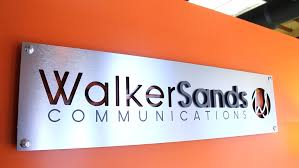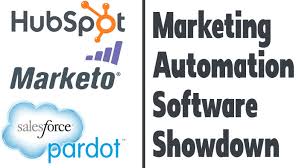The Seattle24x7 How-To Interview on Marketing Automation with Brooke Bartos of Walker Sands

Ardent science fiction fans will recall the line from 2001: A Space Odyssey that marked astronaut Dave Bowman’s final words as he passed into the monolith of all knowledge known to humankind: “My God, it’s full of stars!”
In 2019, he could’ve been talking about a Marketing Automation System.
Try to imagine the universe of “touch points” that surround your organization’s sales and marketing activities. The physical and virtual connectors between your brand and your customers.

You may be picturing your own market-verse made up of individuals, or as “personas,” or as small teams (as in “account-based marketing” or “ABM”). You may be envisioning a B2C, B2B or B2E (business-to-everyone) target audience.
Then there’s the myriad of hits, clicks, page views, downloads, form fills, and follows, likes, upvotes and downvotes from the social media universe. Whether generated through an ad, a landing page, a Web form, an email campaign, a newsletter, a search engine link or another source, the leads that arrive from across the Web or over the phone all represent shooting stars.
Our “how-to” question emerges: In a computer-mediated environment, how do you manage the sheer volume of interactions that fill up your server logs?
Like counting the stars in the sky, it is not humanly possible.
Over the years, the marketer’s laboratory has evolved from tools like PIMs, contact managers and call trackers to sales engagement software, customer relationship management (CRM) systems, marketing attribution programs, enterprise resource planning software and data analytics programs of many stripes.

As nimble as applications like Salesforce or Microsoft Dynamics may be in recording and analyzing customer interactions, these solutions are largely siloed, not centralized. The job of orchestrating, synchronizing, or at least actualizing the many instruments in the marketer’s toolkit now belongs to the new breed of Marketing Automation systems.
Does it work? Marketing automation can result in a 15% increase in sales productivity as well as a 12% decrease in marketing overhead, according to tech research firm Nucleus Research. Forrester found that B2B marketers implementing marketing automation experience a 10% increase in their sales-pipeline contribution from the start.
A dictionary definition of Marketing Automation might be inscribed as follows: Marketing automation is the use of software and web-based services to execute, manage and automate repetitive marketing tasks and processes to more effectively market through multiple channels. Marketing automation focuses on the definition, scheduling, segmentation and tracking of marketing campaigns, allowing the marketing and sales organizations to nurture leads with highly personalized content aimed at attracting and retaining customers.

As a human Marketing Automation Manager, Brooke Bartos heads a team that focuses on the optimization of marketing automation programs, engagement strategies, omni-channel ABM tactics, lead nurturing and program analytics for Walker Sands Communications which maintains offices in Seattle, San Francisco and Chicago.
A certified expert with numerous advanced Specialization Certifications, Brooke has guided clients in building and optimizing their marketing automation systems to drive actionable leads for sellers, provide robust tracking and analytics, and demonstrate the ROI of marketing. Named to Marketo’s inaugural class of Fearless 50 Global Marketers in 2018, and one of 40 Marketo Champions globally, Brooke is battle-tested in tackling the hard challenges that come with an ever-changing marketing landscape.

Seattle24x7: Welcome, Brooke. Let’s take it from the top. What is the very first step to take in preparing to acquire or implement a Marketing Automation system?
Bartos: Would you be surprised if I told you it was a business mindset compared to technology? In this era of digital marketing, so much of planning focuses exclusively on the mechanics of your marketing system. The right approach is to calibrate whether your marketing automation plan is aligned with your business goals.
Only when there is a proper alignment with your business objectives should the focus shift to mechanics and execution. Defining your business plans can also unite your team around a common vision for improving your use of marketing automation. It’s no surprise that it’s the go-to first step for all of us who work in marketing automation consulting. Diagnosis first, prescription second.
Seattle24x7: The maxim is that your business planning tells you where you are going. Your marketing plan informs how to get there. So once the business aims are established, what is the right way to go about a marketing system audit?
Bartos: The key to running a good marketing automation system audit is to avoid boiling the ocean. There’s quite a bit to investigate so a triage approach is advisable. Ask yourself, what’s critically important to fix in a hurry? Where do we need to stop the bleeding? At a minimum, you want to be sure you do not get stuck in a way that prevents engagement. It’s vitally important that the leads you are generating will get the proper attention of your Sales team. Without this level of marketing automation health, your entire business can be at risk.

Seattle24x7: You espouse a comprehensive diagnostic approach at Walker Sands. Can we run through the typical set of questions that comprise an initial assessment?
Bartos: Sure. Let’s break it down in three areas. 1.) a company’s sales and marketing culture and infrastructure; 2.) the legacy systems that will need to be integrated; 3.) the marketing interface.
Seattle24x7: Okay, let’s start with corporate culture…
Bartos: This set of questions begins with measuring expectations and priorities. What is upper management’s perspective on ROI for a marketing automation system? Are expectations being set? Can they be met? Is there a documented marketing automation strategy or plan within the organization?
How will our marketing automation strategy and execution compare to that of our top three competitors? Are we the best and if not how will we leapfrog others? Who will be running the marketing automation system internally and are there any skill or knowledge gaps that need to be addressed? Does the team have enough people to do the work? Will the hand-off of leads to Sales be appropriately tracked and managed such that there is a strong feedback loop with revenue attribution? How will marketing automation tasks be made more efficient to free up time?

Next, has the company done a content audit to isolate content gaps for key markets, niche audiences, offerings, key messages, delivery formats and channels? Has the company addressed potential cybersecurity risks that are relevant to the marketing automation system? Of all the things that need to be fixed or improved, which one’s have the best and fastest ROI for the least effort? How are all possible initiatives prioritized against business impact?
Seattle24x7: What are the key marketing considerations to process?
Bartos: You remember the classic marketing trope – If you don’t know where you’re going, how will you know when you get there? To make sure you reach your intended destination, you’ll be needing all-wheel drive. Is the marketing team looking at the right reports and performance indicators? Is there consensus on the lead scoring methodology and can it be improved upon? Does the company know the top attrition point in its marketing funnel and are they taking steps to correct it? Do reports accurately provide insights on performance by marketing channel? The user experience that is coming from the organization’s marketing engine should be clearly planned, understood and any defects corrected.
Onboarding Your Test Flight

Once you have determined that marketing automation software makes sense for your business, spend time researching individual vendors and their capabilities by doing the following:
1) Make a list of all the marketing automation capabilities you currently have (i.e., email blasting), those that you would like to have (i.e., predictive scoring or recommendations) and those that you can’t live without (i.e., plug-and-play CRM integration). This last category is critical and could help you avoid a costly mistake.
2) Narrow your list down to the vendors that meet your criteria. Submit your list of the marketing automation capabilities you’ve identified and set a timeframe for the vendors to reply.
3) Set up demos with your short list of vendors. Make sure all your internal users participate.
Seattle24x7: Marketing Automation has streamlined the process of managing hundreds of data points in the marketing conversation, but it also initiates those conversations. Creating relevant content for each customer or constituency is essential. How should a marketer approach content creation for the myriad of interactions that will be engaged, and tested, between the system and its targeted audience members?
Bartos: A company needs to tailor its content marketing assets to cater to buyers at every stage of the customer journey. That means understanding which content assets perform best with respect to specific business goals. Every piece of content should have a distribution plan that is continuously assessed for effectiveness. The logic and setup for drip campaigns, triggers and automation rules need to be optimized accordingly.
A content production plan should be prioritized to meet the most pressing business goals first. But don’t forget, your Marketing Automation engine will power all marketing channels including paid online advertising, remarketing ads, and social media. All must be smartly integrated and connected, and strike the right balance between evergreen and non-evergreen content.
Price Points

How are you budgeted for your investment in Marketing Automation? You will typically have two ways to pay — by the number of contacts in your database or by the number of emails you send each month. PCMag ran the numbers.
For example, the Growth Pardot plan costs $1,250 per month for email marketing, prospect tracking, lead nurturing and scoring, reporting, forms and landing pages, and standard Salesforce customer relationship management (CRM). This plan can be upgraded to two higher tiers, each of which offers additional features, plug-ins, and add-ons. However, all three Pardot plans give you capacity for 10,000 contacts.
Pardot’s price tag is at the upper end of the cost range. HubSpot’s Marketing Hub lets you store 1,000 contacts for $50 per month in its Starter plan, $800 per month for its second-most feature-rich plan, and $3,200 for the Enterprise plan.
On the lower end of the pricing spectrum, you’ll find products such as Infusionsoft, which costs $299 per month for five users, 5,000 contacts, and unlimited emails per month. The complete package also includes Infusionsoft’s four core feature sets (CRM, e-commerce, marketing automation, and sales automation) at no extra charge.
SendinBlue and Zoho Campaigns both offer free plans for anyone who is unwilling to spend even a dime for marketing workflows. Both tools scale upward for added capacity and complexity, and each offers pay-as-you-go plans for companies just dipping their toes into email marketing and marketing automation. [24×7]
Seattle24x7: What advice do you counsel for those who want to migrate between Marketing Automation Systems? There are over 200 different brands of Marketing Automation software listed on Capterra so we best just look at the leaders as examples.
Bartos: Let’s take a look at three of the leading marketing automation platforms: Pardot, Marketo or Hubspot. Maybe you bought the wrong solution and are ready to move to a platform that better suits your needs. Maybe there are external forces driving the change, such as an acquisition.
The six migrations, or ports, in this case would face different challenges:
Pardot to Marketo – You’ll need to get used to different terminology (e.g Smart Lists vs Dynamic Lists) when you make this migration, and you’ll want to have your in-house team certified in Marketo ASAP. This can be a fairly straightforward migration if your current instance is in good shape. Another thing to note is that Marketo’s partner ecosystem can integrate directly into the Marketing Automation platform, whereas Pardot usually integrates via Salesforce App Exchange.
Pardot to Hubspot – You’ll like the transition to Hubspot’s lead scoring tool and workflow generators, but you’ll miss many things in Pardot that are not in Hubspot. Due to Hubspot’s desires to be an all-in-one solution for every marketing need, you’ll find the user interface to be more intimidating, but training and time will heal that wound.
Marketo to Hubspot – The time for this migration depends in large part about the complexity of your Marketo use. Marketo power users who bleed purple may bemoan the simplicity of Hubspot, but others will feel more efficient once they adjust to Hubspot.
Marketo to Pardot – Your Marketo power users may be a little disappointed with Pardot’s advanced functionality as compared to that of Marketo, but many people prefer Pardot’s user interface to that of Marketo. We’ve gotten great results for our clients who use Pardot and it’s definitely a powerful tool for B2B marketers, so you should be able to get equivalent results after the migration.
Hubspot to Marketo – For larger B2B companies, the transition from Hubspot enables more complex reporting and workflows. That’s a double-edge sword. You’ll miss the all-in-one feel of Hubspot and Marketo’s complexity can be intimidating at times. But this is an upgrade path we know well, and it usually works out just fine.
Hubspot to Pardot – Pardot reporting, which is pretty limited, is shockingly simple to former Hubspot users. The migration plan should make sure reporting is done via Salesforce dashboards or a business intelligence tool (e.g. PowerBI) that taps into a data warehouse which is synced to everything in your sales and martech stack.

Capterra Reviews Over 200 Marketing Automation Software Programs
“With the push towards digital and social media marketing, marketing professionals have a lot of inbound channels to oversee at once,” said Capterra President and CEO, Michael Ortner.
“The great thing about Marketing Automation software is that many of the tedious, repetitive tasks marketers face are automated, while the more nuanced tasks are streamlined. It eliminates much of the potential for human error and makes the balancing act of marketing operations a great deal more efficient.”
Capterra, a leading online resource for business software buyers, ranks using its popularity index, a weighted score that incorporates customer and user counts, as well as social presence of the software vendors on sites like Twitter, LinkedIn, and Facebook. [24×7]
Deciding What Marketing Automation Tasks to Do In-House or Outsource
Seattle24x7: Marketing automation is a team sport. How do you decide what to produce in-house vs. outsource?
Bartos: No question, it takes a lot of work and expertise to excel with marketing automation. Some folks prefer to just outsource all the heavy lifting to firms like Walker Sands, engaging us as a managed service to run every aspect of marketing automation.
Alternatively, and more commonly, other clients engage us for a more limited scope of work to provide ongoing support. So it’s important to think through what you want to outsource and what you want to do via your employees.
To determine your marketing automation outsourcing strategy, start with a list of marketing automation tasks, which would include things like:
- Developing the strategy
- Administering the marketing automation system
- Coming up with creative ideas for campaigns
- Making sure outreach aligns with business goals
- Doing the graphic design to support inbound and outbound marketing
- Creating thought leadership and other content to feed the engine
- Wiring up disparate systems through integration
- Creating email templates
- Building B2B video marketing assets to support campaigns
- Writing all the content for nurture emails
- Building out drip campaigns
- Setting up and maintaining lead scoring
- Making sure Sales follows up on leads
- Developing sales enablement materials
- Running and reporting on monthly results
- Conducting marketing automation data hygiene work
- Being responsible for all ongoing marketing automation optimization work
Now, for each item on the list, make an evaluation on two dimensions.
First, is the strategic importance of the task high or low? Second, is the ease with which your internal resources can handle the task high or low?
With two dimensions, you’ve got four possibilities. If the marketing automation task has high strategic importance and high ease with respect to handling internally, don’t outsource it. If it has low strategic value and is hard to do, then that tilts your decision to outsourcing. (Tasks in the other two quadrants of this decision grid require more thinking…or a coin flip.)
If you’ve got, say, twenty sub-tasks for marketing automation, and the vast majority of them are tilting toward outsourcing, that’s when you might want to consider outsourcing everything.
That’s one way of looking at outsourcing. Another approach is to ask: “Is there an agency that can do this better than me and am I willing to pay more than I’d have to pay an FTE to get that improvement?”
Regardless of your approach, you need to figure it out: what do I want to have my agency do and what would I prefer to keep internal?
Seattle24x7: Sounds like it is a good idea to take it slow in the beginning?
Bartos: When outsourcing marketing automation work, we often recommend starting small and gradually expanding the relationship with the marketing automation agency you’ve chosen.
This approach puts less at risk up front. It also lets you see the marketing automation agency in action. If the vendor does good work, understands your business, and is getting good results, then expand the relationship
Seattle24x7: What should a company look for when choosing a Marketing Automation consultant or partner?
Bartos: Be careful when you choose a marketing automation execution partner. It’s surprising but a firm that only does marketing automation work may not be good at marketing in general. A better bet is an integrated marketing firm that, along with many other marketing service offerings, does marketing automation work.
What you are looking for is knowledge of applying marketing automation to the entire marketing lifecycle. Firms that don’t offer broad-based, integrated marketing services and only focus on martech don’t get that knowledge, other than from textbooks.
For us, it’s a virtuous circle that we’d love for you to be a part of. You can try an agency that only does marketing automation but we recommend against it. At a minimum, it’s best to explore your options. [24×7]

Walker Sands is a public relations and digital marketing agency for business-to-business technology companies. With an integrated approach to creative services, Walker Sands helps clients build brand awareness, enhance credibility and drive new business. Walker Sands is a six-time Inc. 5000 honoree and regular recipient of some of the industry’s most prestigious awards from organizations including Entrepreneur, Holmes Report and Hermes Creative. Walker Sands was founded in 2001 and has offices in Chicago, San Francisco and Seattle. Visit Walker Sands online.




















